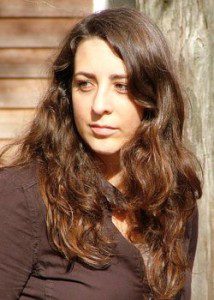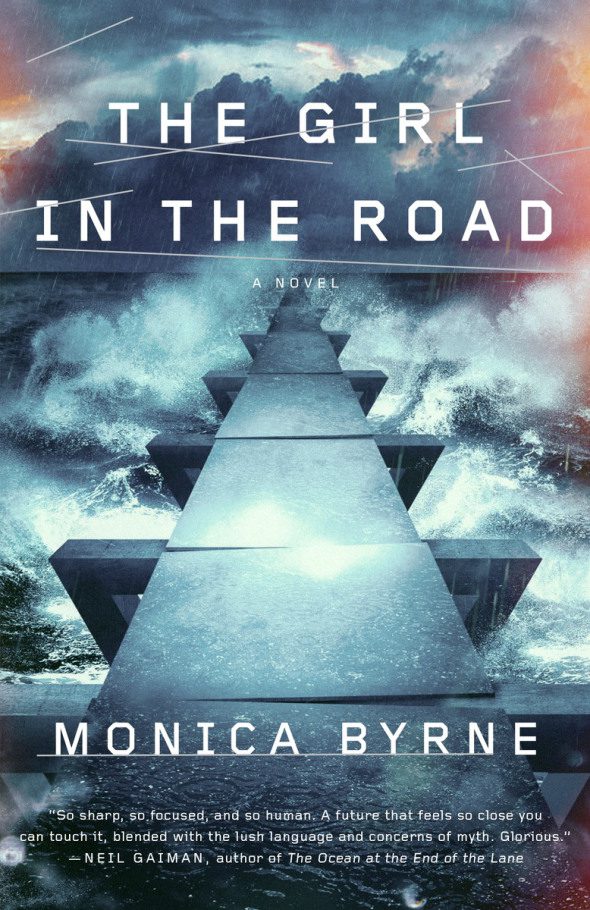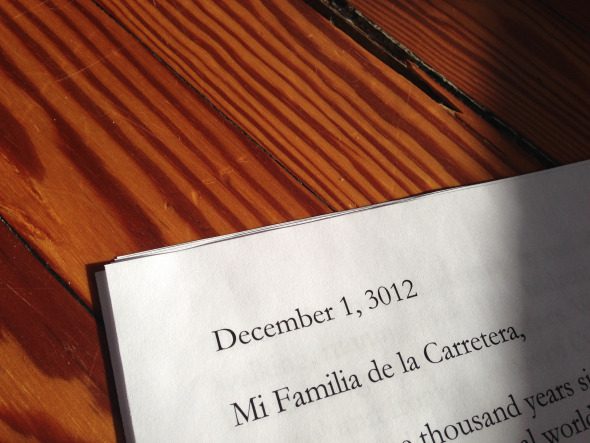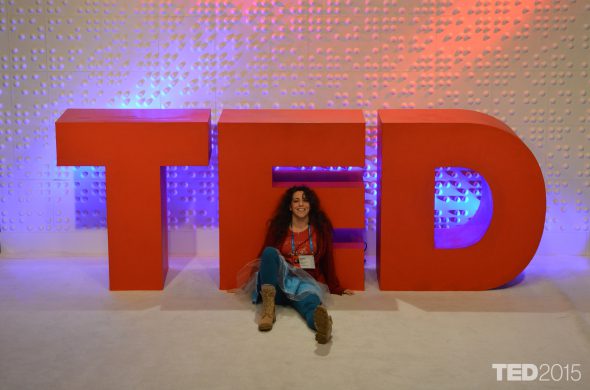
The Girl in the Road by Monica Byrne was one of the first books I read in 2015, and it was far and away my favorite. Set decades in the future, in a world where “Africa is the new India, after India became the new America, after America became the new Britain, after Britain became the new Rome, after Rome became the new Egypt, after Egypt became the new Punt,” it features a cast entirely comprised of characters of color. Almost to a one, they’re queer. I’ve never read anything like it.
I’ve been looking for stories like these since I was a little girl, though it wasn’t until I read The Girl in the Road, and specifically the character of Meena Ramachandran, that I finally felt like I found one. Meena is many things: She is fierce, and angry; she loves passionately, and dangerously; she is incredibly strong, and deeply flawed. She also happens to be bisexual, though in Byrne’s hands, she suffers from none of the clichés to which bisexual characters are often subjected. As a bisexual reader, Meena was profoundly important to me.
I found the book through a book club of likeminded readers and writers. We are all feminist women who value stories that center experiences of Otherness. The books we choose each month all reflect a desire to see characters that look like us, and that we can relate to.
One of the members of my book club grew up in the same town as Byrne and put me in contact with her. Once I finished flailing about how much I loved The Girl in the Road (which recently won the Tiptree Award!) and Meena in particular, we talked about representation in fiction, writing with tropes in mind and against clichés, and the importance of writing stories of the Other.
***
The Rumpus: So my first question is about the almost utopian queer acceptance inThe Girl in the Road, and the way it seems at odds with the lingering misogyny in that world. Everyone is out and proud, STDs are taken care of by nanobiotics, and birth control is the default for everyone. But misogyny—and transmisogyny—are still pretty heavily present in society. Meena works at a clinic for battered women; there are some startling, and stark, descriptions of violence against women; and transwomen still aren’t fully accepted (I’m thinking here of Meena’s grandmother’s response to learning that Meena’s girlfriend is transgender.)
My question is this: What was your reasoning behind having sexuality be the thing that first became most widely accepted? Would attitudes toward sexuality change, or how would the world look different, if people’s attitudes toward race, class, and misogyny had progressed as much as their attitudes toward sexuality?
Monica Byrne: I wouldn’t say that all sexualities are widely accepted in the world depicted in The Girl in the Road. Meena runs in pretty privileged circles—she’s upper class, socioeconomically and educationally, and she lives in a “hippie Keralite enclave.” I read once somewhere—I wish I remember where—that writing outside one’s class is as much “writing the Other” as it is to write another gender, sex, or nationality. In this case, Meena and I are very much in the same boat. We both live in a bubble where it’s easy to be queer. Thrissur in 2068 is like Durham in 2015 insofar as non-cis, non-straight identities are freely expressed in public downtown spaces, but it’s still only pockets. The threat of discrimination and violence is still very present. Different communities have different understandings and tolerance levels. In the Meena sections of TGitR, you see the ones that are more progressive than not.
Thrissur in 2068 is like Durham in 2015 insofar as non-cis, non-straight identities are freely expressed in public downtown spaces, but it’s still only pockets. The threat of discrimination and violence is still very present. Different communities have different understandings and tolerance levels. In the Meena sections of TGitR, you see the ones that are more progressive than not.
As for Meena’s grandmother, yeah, she has a hard time wrapping her head around the idea of trans women. But it’s the kind of thing that’s become unseemly to disapprove of openly, so she resorts to character insinuations instead of outright rejection: “You know her kind,” et cetera. It’s a re-tread of conversations I’ve had with well-meaning older people who mask racism as concern. I mean, they really don’t know it’s racism, let alone that race is an invention.
It makes me wonder what I’ll have a hard time accepting, when I’m eighty-five.
Rumpus: I think what was interesting to me about Meena’s grandmother’s attitude toward Mohini was that it was informed by her generation’s cultural attitude toward trans women—they were singers who performed at the birth of sons, and were accepted in that respect, and only in that respect; that, if I remember correctly, is where Meena’s grandmother’s views came from, and to Meena that was a view that was just atrociously outdated/ignorant.
Byrne: Totally. It was Meena’s grandmother’s way of saying, “I tolerate their kind just fine, but just so you know, here’s what they’re like,” from one encounter that’s become representative in her mind. A la Adichie’s “danger of a single story.”
Rumpus: I think this is in some way related to how I responded to Meena, as a protagonist, and as a bisexual protagonist. The genuineness of Meena—the way her sexuality was hers, and ferociously so—is something that I hadn’t read before and certainly isn’t a way that bisexual characters are commonly portrayed (instead they’re more likely to be promiscuous, or confused, or their sexuality is performative rather than genuine).
Meena’s brashness really resonated with me. Let’s be real: It filled me with glee. Was her “this is who I am, it isn’t for you” attitude a conscious choice in writing a bisexual protagonist? Or, I guess, more generally, where did Meena come from?
Byrne: Ha, she comes from me! I just grew up very comfortable with my sexuality. And I was always in full ownership of it, which sadly, in this society, is not necessarily a common experience for a woman. I didn’t get it from school—on the contrary, my high school was conservative Catholic—but from a really progressive, supportive family and women’s college.
It also comes from reading interviews with Meshell Ndegeocello, my favorite singer-songwriter on whom Meena is partially based. Meshell was openly bi back in the ’90s. In fact, she’s the first public figure I remember being bi—that that was a thing one could be. Her songs are also incredibly sexual. Listen to “Barry Farms”: “Can’t nobody eat my pussy the way that you do”—gah.
I think Meena does use sex as an escape, but that doesn’t have to do with her being bisexual; it has to do with her having a troubled family background. I think she also just genuinely loves sex and has a high sex drive. It’s her creative medium. She doesn’t perform it except for her lovers, though of course, that careless attitude is part of what makes her so hot. Now that I write that, I’m realizing there’s a good deal of my college crush in Meena.
Rumpus: I’m also lucky enough to have a pretty supportive family, also Catholic, but we used to be much more traditional. I do wonder if I would have come to Jesus moment with regard to sexuality, though, if I’d had more characters like Meena in my life growing up.
Another thing I wanted to talk about is sort of related to what you said about Meena using sex as an escape. To me, this read as very separate from and unrelated to her identity as bisexual—like you said, it is related to her troubled family history. Was it something you thought about when writing her, though? Were you worried that some might read her sexual history as part of the “promiscuous bisexual” trope?
Byrne: For sure, but not enough to represent her otherwise. Tropes aren’t the same thing as clichés; they’re just something to be aware of. Some people just really love sex. Meena is one of them. I trust my readers to understand the distinction.
Rumpus: More generally, I’d like to talk writing against clichés, specifically with characters who are traditionally othered. This also ties into the danger of a single story:  We simply don’t have very many stories that are centered on characters of color or queer characters. This puts a lot of pressure on the character we do have to do everything right.
We simply don’t have very many stories that are centered on characters of color or queer characters. This puts a lot of pressure on the character we do have to do everything right.
For example, I was incredibly invested in the idea of Meena being pursued by a terrorist organization, and that’s why she was fleeing. When it was revealed that she actually fled because she attacked Mohini after discovering Mohini had been cheating on her, my knee-jerk reaction was to be a little let down? Love or jealousy as motivation felt disappointing to me, initially. Those motivations felt “smaller” to me, in some way, than if Meena been being pursued by a terrorist organization for being an activist, or something along those lines.
Byrne: Ha! Yeah, sorry, Meena was never being pursued by a terrorist organization. Meena is the terrorist organization. She creates a massive construct around the thing she doesn’t want to face in herself. And how much of actual violence in the world stems from exactly that?
Rumpus: Right. And I do think there is definitely a lot of value in having a character be flawed in the way that Meena is flawed, for her personal motivations to be all-encompassing. That’s part of what being a person is. But female characters are often Female Characters first; there is extra work for them to do. Similarly, female characters who are motivated by love, even an unhealthy love—those motivations aren’t less than simply because the characters are women, though I think sometimes we’re taught to think so.
Byrne: I can’t really relate to the idea that love is a “less than” motivation. Literally, less than what? To me, that’s all there is. All motivations come from love, including violent ones. During my monogamous years, I felt enormous upwellings of violence when I found out I was being cheated on, and never acted on them physically, but felt like I came very close at times. Jealousy was an incredibly destructive force in my life for years. I wanted to explore where that impulse came from.
Rumpus: I guess I sort of just meant that I went into the book assuming that Meena, through her work at the women’s clinic, had done something radical and political and was a target of a terrorist organization because of that. That seemed to me, originally, to be on a “bigger” scale, in terms of motivation for her journey. Although, in Jason Heller’s NPR review of The Girl in the Road, he writes ”personal apocalypses have taken the place of global ones,” and allowing Meena the space to experience her own personal apocalypse, I think, is revolutionary in its own right.
Byrne: Yeah. We want Meena to be a hero in the classic sense. That’s natural. But here’s the thing: so much evil in the world stems directly from our individual inability to (borrowing the Christian idiom) see the plank in our own eye and in those of our heroes. I feel like I’m in a meteor shower of falling stars these days—heroes we exalted, and that exaltation protected them in doing terrible evil. I’m thinking of my childhood hero Bill Cosby, but there are so many others. Disappointment in Meena is understandable, for sure, but could also be seen as reflective of the problems inherent in hero-making.
Rumpus: Exactly. I think in writing Meena as a strong, brash character who is aware of the ways in which women are mistreated and brutalized, and yet also having her be capable of abuse really speaks to that. It’s incredibly humanizing, and while it might not be pretty to look at, I think it’s important to have queer characters and character of color who are allowed to be human, even if that means being human in imperfect, and often ugly, ways.
So I’d like to know some of your thoughts about writing against tropes. Do you feel any tension in terms of writing “positive” portrayals of queer characters and characters of color, vs. allowing the characters you write to be authentic—whether or not their depiction is necessarily “positive”?
Byrne: Yeah, it just never occurred to me to write an idealized character. I’m out of my depth if I try to address the whole history of representation of brown characters by white writers, but suffice to say, no one’s race makes them magical. Pretending otherwise is just as racist as any other stereotype.
But at the same time, I was definitely concerned about indulging stereotypes that I may not have been fully aware I’d internalized. I worried about that in portraying both violence (on Meena and Mariama’s parts) and cheating (on Mohini’s part). As for the former, women are almost always portrayed as victims of violence, without violent capabilities of their own, that it actually seemed to be very counter-stereotypical to present them as having agency in that regard. As for Mohini, it’s just one of those situations where she was cheating on her partner, like much of humanity does, and also happens to be transgender. I have wondered, though, whether part of Meena’s rage was about “discovering” that her grandmother had been “right.” I can’t idealize my characters, but characters can idealize other characters, and I think Meena definitely did that, with Mohini. She needed her to be perfect. She was enraged when she found out she wasn’t. Understanding the source of that rage is what the book’s all about.
Rumpus: One of the things that was so distinct about The Girl in the Road was just how much emphasis was placed on the relationships between women: Meena and Mohini, Mariama and Yemaya: women in love, in lust, women with obsessions, women driven by love and jealousy and rage.
As you wrote in your piece for the Atlantic, you’d grown up reading mostly male protagonists. How did it feel to write a book with such a profound focus on not one but two female protagonists, and their relationships with other women?
Byrne: Definitely, relationships between women are central to the book. I wrote them that way because I couldn’t come up with any good reason for them not to be. I’m conditioned, as we all are, to make a man the “stable reference point” of any narrative, but I wanted to see what would happen if I didn’t do that. Of course, what happened is that I got to express the full spectrum of human behavior solely through women. Which is my reality. It’s all of our reality, actually, though our expectations shape our perception so strongly.  For example, my sister was reading The Girl in the Road, and she told me she kept bracing for Mohammed and Francis to do something awful to Mariama. But they are actually quite kind to her. Yemaya is the one from whom violence comes.
For example, my sister was reading The Girl in the Road, and she told me she kept bracing for Mohammed and Francis to do something awful to Mariama. But they are actually quite kind to her. Yemaya is the one from whom violence comes.
To center women’s relationships felt very satisfying. I feel like so many writers are trying to satisfy some external notion of what is good or true, and that “external notion” often just ends up being cultural conditioning. Which means they produce a literature that just reinforces the culture, instead of querying or changing it. I could tell when I was writing that way; it didn’t sit right in my belly. I had to keep asking myself, What is true for me?
Rumpus: So my last questions for you are about the future—both for you, as a writer, and about writing the future. How has writing “the future you wanted to see, and the future you could reasonably expect to see” changed given the grander scope of The Actual Star since it spans millennia, rather than being set decades in the future?
Byrne: Writing the future of 3012 is way different from writing the future of 2068. I have much more freedom in creating a new world, but I also have far fewer data to extrapolate from. Both are a fun set of constraints. A few things will almost certainly happen—global sea level rise, for example—but lot of other shit can happen in a thousand years. So will it be like Le Guin’s Always Coming Home of peaceful socialist settlements? Or Kim Stanley Robinson’s 2312 of solar system colonization and balkanization?
Well, my future is dominated by a new pilgrimage religion whose aim is “falling through” to a parallel universe. But the religion is a thousand years old, and has long fragmented into schisms, with some believing that “falling through” is a physical reality, and others believing it’s just a metaphor for a mental transition. But all sects agree that the ancient Maya were the ones who first recognized the parallel universe, and called it Xibalba, the Otherworld.
It’s fun as hell. I’ve been obsessed with the idea of travel as religion for a year now. This is how I’m pushing it to its logical extremes.
Rumpus: And finally, I wanted to ask about the roads that bring us to the future. The Actual Star begins ”mi familia de la carretera” (“my family of the road”). How has your relationship to roads, to journeys, changed since The Girl in the Road was published?
Byrne: Roads keep showing up in my work! They just did again when I read at TED last week! Walked on, more often than not. Whenever I get to a new city, my first instinct is to walk it exhaustively. That’s how I make an experiential cartography of it.
But there’s always an element of assessment: “Is this a home? Is this a home?” I’ve felt that way immediately about some places (San Ignacio, Belize) and immediately not about others (San Jose, Costa Rica). If my relationship to roads and journeys has changed at all since The Girl in the Road was published, it’s just gotten more intense. My dream is to become a semi-permanent traveler, actually, living on the road. There’s just too much to see. Would that I could live every life that’s ever been lived on this planet!




